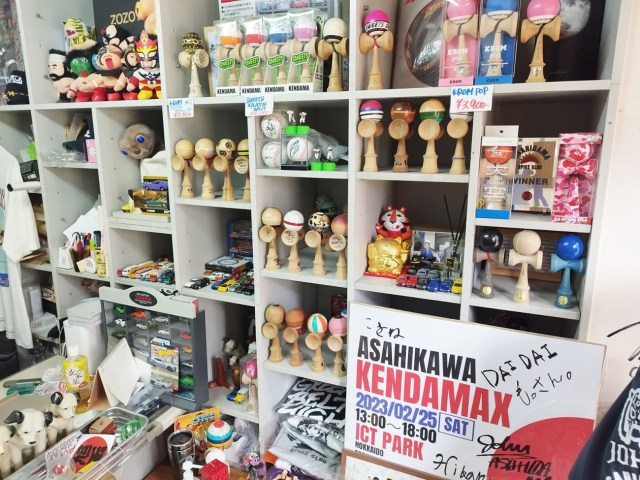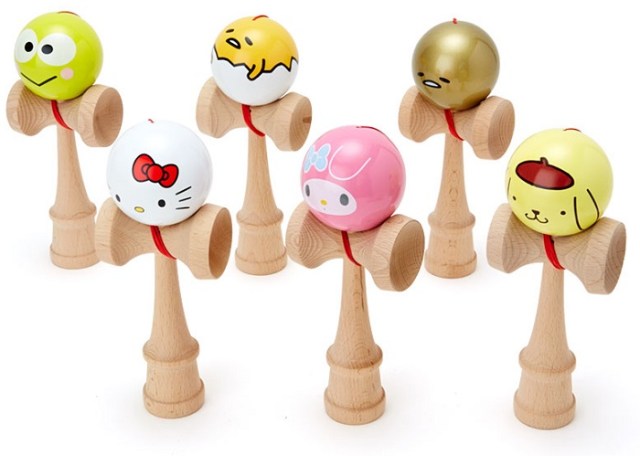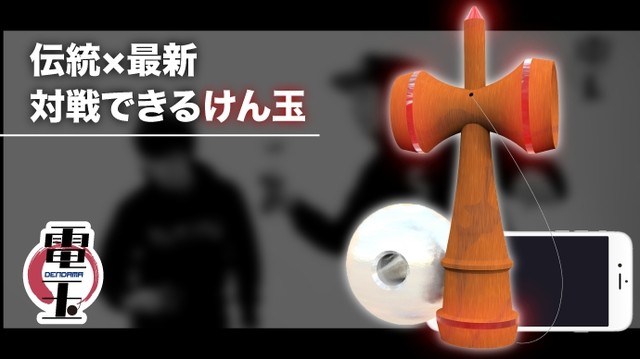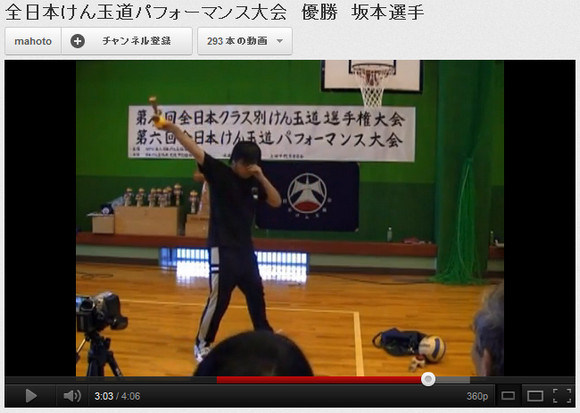The journey of kendama, from a childhood toy to an extreme sport, is being celebrated at this small shop in Japan’s north.
Kendama
Most people in Japan outgrow this game by the time they finish grade school, but Kyoko Fukada had adults’ attention.
If you’ve been waiting, now is the perfect time to take up the traditional children’s game!
Equipped with a range of sensors and motion detectors, the Dendama looks set to bring this classic toy into the 21st century.
Almost everyone in Japan has played kendama at some point in their lives. Most people learn how to play it as a pastime during their childhood, then eventually move on to other activities after they get the hang of it and become bored. A select few, however, go on to hone their skills to perfection and actually compete in organized competitions similar to yo-yo tournaments. Enter 22-year-old Hiroki Iijima, who has not only mastered all the regular tricks in the book but has also combined his love for street dancing to create a new freestyle activity: “kendama street dancing,” if you will.
Skeptical? We’ve got video proof of Hiroki’s awesome skills right here. Prepare to be dazzled!
The other day, I was trawling through YouTube looking for shamisen music videos when I came across an utterly unique video called “Tokyo Kendama Project vol.2 Utakata.”
It featured the traditional Okinawan sansen three-stringed instrument played by the mysterious Gosamaru and composed by Tomoaki Ogre, the beautiful dancing of Kumi Arikawa, and a pair of strangely hypnotic gentlemen spinning some… things through the air. I’d heard of kendama before, as I imagine most people with even a fleeting knowledge of Japan have, but I’d never seen the toy wielded with such incredible finesse.
Fascinated, I had to know more!
First of all, you might be wondering, “What’s kendama?” Well, it’s a popular children’s toy that is kind of like a cup-and-ball game on steroids. However, rather than a single cup, this game has three of varying sizes, and they aren’t so much “cups” as they are shallow saucers that are meant to hold the ball. And if that’s not enough, there’s an extra spike that you’re expected to skewer the ball on exactly through a pre-made hole. The purpose of this game being not only to get the ball into a cup but to also juggle it between cups or spike without dropping it.






 Starbucks Japan ready to get Year of the Horse started with adorable drinkware and plushies【Pics】
Starbucks Japan ready to get Year of the Horse started with adorable drinkware and plushies【Pics】 7 great places to see Mt. Fuji from without having to climb it
7 great places to see Mt. Fuji from without having to climb it Do you know what this caterpillar-like food is? We had no idea!【Taste test】
Do you know what this caterpillar-like food is? We had no idea!【Taste test】 Japanese thug wear from Birth Japan perfect for those breaking bad next year
Japanese thug wear from Birth Japan perfect for those breaking bad next year The cheapest place to stay in Kyoto cost us just 1,800 yen for the night, and it was awesome
The cheapest place to stay in Kyoto cost us just 1,800 yen for the night, and it was awesome How much difference does the choice of mold make in fermenting food?
How much difference does the choice of mold make in fermenting food? We turn 100,000 yen into 100,000 one-yen coins, in the spirit of New Year’s generosity
We turn 100,000 yen into 100,000 one-yen coins, in the spirit of New Year’s generosity Japan’s oldest largetooth sawfish in captivity back on display in Mie Prefecture
Japan’s oldest largetooth sawfish in captivity back on display in Mie Prefecture Japanese fashion company brings modern-day samurai look to your legs with hakama chino pants
Japanese fashion company brings modern-day samurai look to your legs with hakama chino pants Is it rude to sing along at concerts in Japan? We ask a pro musician for his take
Is it rude to sing along at concerts in Japan? We ask a pro musician for his take Lacquerware supplier to emperor of Japan and Pokémon team up for new tableware
Lacquerware supplier to emperor of Japan and Pokémon team up for new tableware Japan may add Japanese language proficiency, lifestyle classes to permanent foreign resident requirements
Japan may add Japanese language proficiency, lifestyle classes to permanent foreign resident requirements 7-Eleven Japan’s ramen-cooking robot whipped us up a bowl of noodles【Taste test】
7-Eleven Japan’s ramen-cooking robot whipped us up a bowl of noodles【Taste test】 Cyberpunk anime meets traditional culture in Ghost in the Shell gold leaf Japanese changing screens
Cyberpunk anime meets traditional culture in Ghost in the Shell gold leaf Japanese changing screens Disillusionment at Tsukiji’s tourist-target prices led us to a great ramen restaurant in Tokyo
Disillusionment at Tsukiji’s tourist-target prices led us to a great ramen restaurant in Tokyo Hello Kitty Choco Egg figures are an adorable trip through three periods of Japanese pop culture【Pics】
Hello Kitty Choco Egg figures are an adorable trip through three periods of Japanese pop culture【Pics】 Starbucks Japan releases new zodiac chilled cup drink for 2026
Starbucks Japan releases new zodiac chilled cup drink for 2026 Japan’s otoshidama tradition of giving kids money at New Year’s gets a social welfare upgrade
Japan’s otoshidama tradition of giving kids money at New Year’s gets a social welfare upgrade 7-Eleven Japan starts new temporary luggage storage service in over 300 branches
7-Eleven Japan starts new temporary luggage storage service in over 300 branches Starbucks teams up with 166-year-old Kyoto doll maker for Year of the Horse decorations【Photos】
Starbucks teams up with 166-year-old Kyoto doll maker for Year of the Horse decorations【Photos】 Tokyo considering law requiring more trash cans following litter increase in heavily touristed area
Tokyo considering law requiring more trash cans following litter increase in heavily touristed area Tokyo’s Tsukiji sushi neighborhood asks tour groups to stay away for the rest of the month
Tokyo’s Tsukiji sushi neighborhood asks tour groups to stay away for the rest of the month Nintendo’s Kirby now delivering orders at Kura Sushi restaurants, but not in Japan
Nintendo’s Kirby now delivering orders at Kura Sushi restaurants, but not in Japan Tokyo event lets you travel back in time, for free, to celebrate 100 years since Showa era start
Tokyo event lets you travel back in time, for free, to celebrate 100 years since Showa era start Sanrio theme park in Japan announces plans to expand into a Sanrio resort
Sanrio theme park in Japan announces plans to expand into a Sanrio resort Stamina-destroying “Paralysis Noodles” are Tokyo’s newest over-the-top ramen innovation
Stamina-destroying “Paralysis Noodles” are Tokyo’s newest over-the-top ramen innovation Survey asks foreign tourists what bothered them in Japan, more than half gave same answer
Survey asks foreign tourists what bothered them in Japan, more than half gave same answer Japan’s human washing machines will go on sale to general public, demos to be held in Tokyo
Japan’s human washing machines will go on sale to general public, demos to be held in Tokyo Japan’s deadliest food claims more victims, but why do people keep eating it for New Year’s?
Japan’s deadliest food claims more victims, but why do people keep eating it for New Year’s? We deeply regret going into this tunnel on our walk in the mountains of Japan
We deeply regret going into this tunnel on our walk in the mountains of Japan Studio Ghibli releases Kodama forest spirits from Princess Mononoke to light up your home
Studio Ghibli releases Kodama forest spirits from Princess Mononoke to light up your home Major Japanese hotel chain says reservations via overseas booking sites may not be valid
Major Japanese hotel chain says reservations via overseas booking sites may not be valid Put sesame oil in your coffee? Japanese maker says it’s the best way to start your day【Taste test】
Put sesame oil in your coffee? Japanese maker says it’s the best way to start your day【Taste test】 No more using real katana for tourism activities, Japan’s National Police Agency says
No more using real katana for tourism activities, Japan’s National Police Agency says Starbucks Japan reveals new sakura drinkware collection, inspired by evening cherry blossoms
Starbucks Japan reveals new sakura drinkware collection, inspired by evening cherry blossoms Updated cherry blossom forecast shows extra-long sakura season for Japan this year
Updated cherry blossom forecast shows extra-long sakura season for Japan this year How much difference does the choice of mold make in fermenting food?
How much difference does the choice of mold make in fermenting food? We turn 100,000 yen into 100,000 one-yen coins, in the spirit of New Year’s generosity
We turn 100,000 yen into 100,000 one-yen coins, in the spirit of New Year’s generosity Japan’s oldest largetooth sawfish in captivity back on display in Mie Prefecture
Japan’s oldest largetooth sawfish in captivity back on display in Mie Prefecture Japanese fashion company brings modern-day samurai look to your legs with hakama chino pants
Japanese fashion company brings modern-day samurai look to your legs with hakama chino pants Is it rude to sing along at concerts in Japan? We ask a pro musician for his take
Is it rude to sing along at concerts in Japan? We ask a pro musician for his take From the Grape Picker to the Alchemist: anime-decorated “ita bags” now come in six categories
From the Grape Picker to the Alchemist: anime-decorated “ita bags” now come in six categories Spirited Away bath herbs now available at Ghibli exhibition in Japan
Spirited Away bath herbs now available at Ghibli exhibition in Japan Hello Kitty Choco Egg figures are an adorable trip through three periods of Japanese pop culture【Pics】
Hello Kitty Choco Egg figures are an adorable trip through three periods of Japanese pop culture【Pics】 More Than a Capsule Stay: Why Solo Travelers Choose “global cabin Yokohama Chinatown”
More Than a Capsule Stay: Why Solo Travelers Choose “global cabin Yokohama Chinatown” Happy New Year from SoraNews24!
Happy New Year from SoraNews24! Sumo Sanrio! Hello Kitty and pals team up with Japan Sumo Association for new merch【Pics】
Sumo Sanrio! Hello Kitty and pals team up with Japan Sumo Association for new merch【Pics】 The results are in from our one million-yen stack of Japanese lottery tickets! So, are we rich?
The results are in from our one million-yen stack of Japanese lottery tickets! So, are we rich?